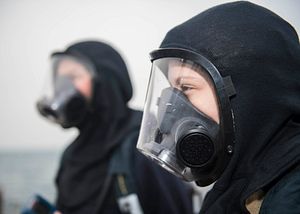The United States and South Korea have confirmed that their annual mass mobilization military exercise, Foal Eagle, will begin on April 1 after a postponement earlier in the year for the Winter Olympics. The U.S. Department of Defense confirmed the timing of the exercise in a statement on Monday.
“Secretary of Defense James N. Mattis and the Republic of Korea Minister of National Defense Song Young-moo have agreed to resume the annual combined exercises including Foal Eagle and Key Resolve, which were deconflicted with the schedule of the Olympic Games,” the Pentagon noted on Monday. “The exercises are expected to resume April 1, 2018, at a scale similar to that of the previous years.”
“The United Nations Command has notified the Korean People’s Army on the schedule as well as the defensive nature of the annual exercises,” the statement continued. North Korea perceives the exercises as a ruse toward an invasion of its territory and protests them every year in its state-run media.
The allied announcement comes as North Korean government officials, led by Choe Kang-il, a foreign ministry official who works on the North American affairs portfolio, meet with nonofficial South Korean and U.S. representatives for talks in Finland. The allied announcement on Foal Eagle alongside the Track 1.5 meeting in Finland suggests Washington and Seoul are taking a two-track approach to North Korea for the moment.
This year’s exercises are anticipated amid an unusually active period of inter-Korean and U.S.-North Korea diplomacy. South Korean President Moon Jae-in is slated to meet North Korean leader Kim Jong-un at the end of April for the third-ever inter-Korean summit; Moon would become the first foreign leader to meet Kim since his assumption of power in North Korea in December 2011. Meanwhile, U.S. President Donald J. Trump has accepted an invitation from Kim for what would be the first U.S.-North Korea summit — an event that is meant to take place by May 2018.
North Korea has yet to confirm a U.S.-North Korea summit, but has reportedly given its word to South Korea that it would understand if the alliance went ahead with the Foal Eagle exercises. That’s uncharacteristic, given Pyongyang’s long-standing opposition to exercises by the alliance — dating back to Kim Il-sung, Kim Jong-un’s grandfather. North Korea has also given assurances to South Korea that it will voluntarily freeze nuclear and ballistic missile testing until the U.S.-North Korea summit.
Officials from South Korea and the United States have been keen to point out that it is entirely according to plans that this year, for the first time in four years, Foal Eagle will not see the participation of a U.S. Nimitz-class aircraft carrier — hence the addition to the Pentagon’s statement that the “scale” of this year’s exercise is similar to previous years. This year’s exercise likely also won’t see the participation of B-1B Lancer conventional supersonic bombers or nuclear attack submarines.
A carrier could have easily participated, however. USS Carl Vinson (CVN 70) spent March visiting Vietnam and conducting an exercise with Japan in the Western Pacific; it could have been diverted toward the Peninsula. (USS Ronald Reagan, forward-deployed with the U.S. 7th Fleet at Yokosuka, is undergoing maintenance.) Even with the conspicuous absence of a carrier this year, the exercises will be much shorter — presumably to avoid any overlap with the planned timing of the inter-Korean summit at the end of the month. In mid-April, the allies will initiate the computerized Key Resolve exercise, wrapping up before the summit too.
It’s not out of the question that there’s a tacit — or even explicit — understanding here for both sides to save face. The alliance gets to claim that it is carrying on with the first mass mobilization exercises since North Korea tested a intercontinental-range ballistic missile for the first time last July, amplifying alliance decoupling concerns. (The Ulchi-Freedom Guardian exercise last September was a computerized command post drill.) Meanwhile, Pyongyang gets a real concession too, with the alliance withholding from involving so-called “strategic assets.”
What’s striking here is that despite the United States, South Korea, and North Korea having shown little interest in the so-called “freeze-for-freeze” idea that was championed by China and Russia last summer, they’ve ended up adopting a similar approach. The alliance has held off on involving strategic assets in this year’s Foal Eagle drills in exchange for North Korea submitting to a testing freeze. Neither side is keen to frame matters this way, of course.
A final thought on all this is that Kim Jong-un may concern himself with audience costs among the North Korean elite and will no doubt proceed with his own readiness drills as the alliance enters Foal Eagle. Similar reason may have motivated his reasoning to hold a military parade the day before the Winter Olympics began in South Korea, kicking off the current bout of diplomatic outreach.
Last year, North Korea launched five extended-range Scud ballistic missiles on a trajectory resembling a strike on the U.S. Marine Corps base at Iwakuni in Japan. Doing that this year would violate the freeze and scuttle both summits, but Kim will seek to make a proportionate and measured show of force, to convey the message — to North Koreans as well the United States and South Korea — that if diplomacy fails, there remain other means to settle differences between the two sides.

































